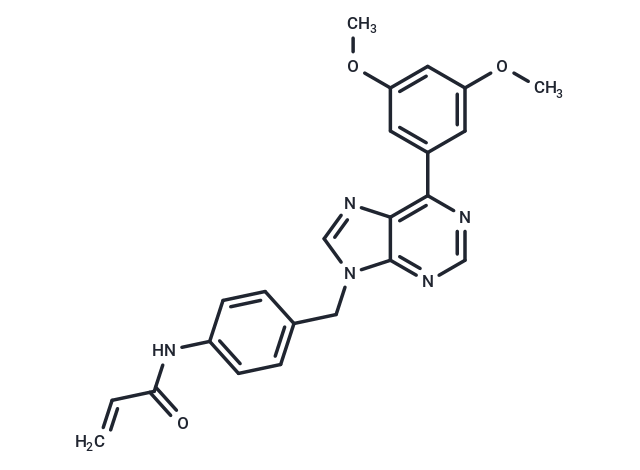Shopping Cart
- Remove All
 Your shopping cart is currently empty
Your shopping cart is currently empty

FGFR-IN-13 (compound III-30), an irreversible covalent inhibitor of the fibroblast growth factor receptor (FGFR), effectively modulates signaling through FGFR1 (IC 50 = 0.20 ± 0.02 nM) and FGFR4 (IC 50 = 0.40 ± 0.03 nM). It suppresses the expression of crucial proteins such as total-PARP and Bcl-2, while enhancing the expression of Cleaved-PARP and Bax in a dose-dependent manner. Notably, FGFR-IN-13 demonstrates considerable antitumor and oral activity [1].

| Pack Size | Price | Availability | Quantity |
|---|---|---|---|
| 10 mg | Inquiry | 10-14 weeks | |
| 50 mg | Inquiry | 10-14 weeks |
| Description | FGFR-IN-13 (compound III-30), an irreversible covalent inhibitor of the fibroblast growth factor receptor (FGFR), effectively modulates signaling through FGFR1 (IC 50 = 0.20 ± 0.02 nM) and FGFR4 (IC 50 = 0.40 ± 0.03 nM). It suppresses the expression of crucial proteins such as total-PARP and Bcl-2, while enhancing the expression of Cleaved-PARP and Bax in a dose-dependent manner. Notably, FGFR-IN-13 demonstrates considerable antitumor and oral activity [1]. |
| In vitro | FGFR-IN-13 forms a covalent, irreversible bond with FGFR protein at 10 μM over 9 hours, effectively suppressing p-FGFR protein expression in MDA-MB-231 cells, rivaling AZD4547 and TAS-120. At concentrations of 2.5, 5, and 10 μM for 24 hours, it induces apoptosis in a dose-dependent manner, outperforming AZD4547 (45.4% vs. 37.3% at 5 μM), suggesting a similar mechanism yet demonstrating greater sensitivity in MDA-MB-231 cells. When used at 1.25, 2.5, and 5 μM for 12 hours, FGFR-IN-13 effectively inhibits cell migration without significant toxicity, also in a dose-dependent fashion. Furthermore, treatment at 2.5, 5, and 10 μM over 12 hours leads to apoptosis through excess ROS production and MMP reduction. A Western blot analysis on MDA-MB-231 cells showed that a 10 μM concentration inhibits FGFR protein autophosphorylation, with suppression of p-FGFR protein expression persisting 8 hours post-treatment. Cell cycle analysis revealed apoptosis induction in a dose-dependent manner, achieving 56.8% apoptosis at 10 μM after 24 hours. In a proliferation assay conducted over 72 hours, FGFR-IN-13 exhibited superior inhibitory effects on KYSE-150 cells (IC50 = 1.93 μM) compared to two positive controls. |
| In vivo | FGFR-IN-13, administered orally at doses of 10 and 30 mg/kg once daily for 21 days, inhibits tumor growth in a dose-dependent manner while maintaining a favorable safety profile in the MDA-MB-231 xenograft tumor mouse model [1]. At 30 mg/kg, it achieved a tumor growth inhibition (TGI) of 64.21%, and at 10 mg/kg, a TGI of 40.22%, without causing significant weight loss. |
| Molecular Weight | 415.44 |
| Formula | C23H21N5O3 |
| Cas No. | 2962941-25-7 |
| Storage | Powder: -20°C for 3 years | In solvent: -80°C for 1 year | Shipping with blue ice. |

Copyright © 2015-2025 TargetMol Chemicals Inc. All Rights Reserved.